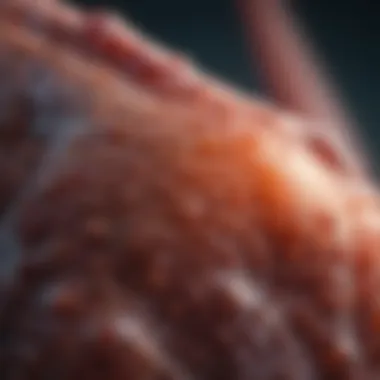Understanding PD-L1 in Prostate Cancer Pathology


Intro
Prostate cancer remains one of the most prevalent cancers among men worldwide. Recent advancements in understanding the tumor microenvironment highlight the role of immune checkpoints in cancer progression and therapy. Among these checkpoints, Programmed Death-Ligand 1 (PD-L1) has emerged as a critical player in modulating immune responses in various malignancies, including prostate cancer. This article undertakes a thorough exploration of PD-L1 expression, delving into its implications for prognosis and treatment response.
The interplay between tumor cells and the immune system is complex. PD-L1, expressed on tumor cells, interacts with the PD-1 receptor on T cells, leading to immune evasion which allows cancer cells to thrive. Studying PD-L1 expression not only provides insights into tumor behavior but also aids in developing targeted therapies that could improve treatment outcomes.
Understanding PD-L1 expression in prostate cancer poses several challenges and opportunities. The following sections will systematically explore this topic, providing a detailed narrative on current research findings, methodologies employed, and the implications for future therapeutic strategies.
Research Overview
Summary of Key Findings
The literature strongly suggests that there is heightened PD-L1 expression in a subset of prostate cancers. Increased levels of PD-L1 are often associated with more aggressive disease phenotypes and poorer prognosis. Contrary to some solid tumors, the role of PD-L1 in prostate cancer appears to be context-dependent, influenced by factors like tumor mutational burden, stage, and the surrounding immune landscape.
- Key findings include:
- PD-L1 is linked to immune evasion in prostate cancer.
- High expression correlates with specific tumor characteristics like lymph node involvement.
- PD-L1 may serve as a biomarker for patient stratification in immunotherapy approaches.
Relevance to Current Scientific Discussions
PD-L1 is a focal point of many current scientific discourses. It bridges the gap between immunology and oncology, emphasizing the necessity of immune checkpoint inhibitors in cancer treatment. In prostate cancer, where traditional therapies often fail to achieve lasting responses, exploring PD-L1 may unlock new avenues for immunotherapy. Discussions are also expanding around combination therapies, where PD-L1 targeting is paired with other modalities for enhanced efficacy.
Methodology
Research Design and Approach
The exploration of PD-L1 expression in prostate cancer has led researchers to utilize a variety of methodologies. They employ both in vitro and in vivo models to elucidate the biological mechanisms of PD-L1. Cohort studies provide valuable clinical insights, assessing patient samples to ascertain PD-L1 expression levels. Many studies also utilize retrospective analyses to correlate PD-L1 expression with treatment outcomes.
Data Collection and Analysis Techniques
Data collection often relies on tumor biopsy samples, immune profiling, and imaging techniques. Immunohistochemistry is commonly employed to visualize PD-L1 expression in tissue sections. Furthermore, multiplex assays and next-generation sequencing technologies help elucidate the tumor microenvironment and determine the overall immune phenotype. Analysis techniques include statistical assessments that correlate PD-L1 levels with clinical parameters and patient outcomes.
By dissecting these elements, the article aims to shed light on how PD-L1 expression impacts prostate cancer treatment paradigms and where future research may direct its focus.
Understanding PD-L1
Understanding PD-L1 is essential for grasping its role in prostate cancer. PD-L1, or programmed death-ligand 1, is a protein that interacts with the PD-1 receptor on T-cells. This interaction plays a significant role in immune regulation and can affect how cancers, including prostate cancer, evade detection by the immune system.
The exploration of PD-L1 expression offers vital insights into the behaviors of cancer cells and their interactions with the immune landscape. As researchers delve deeper into PD-L1's functions, it has become increasingly clear that the expression levels of this protein can influence prognosis and therapeutic outcomes in prostate cancer patients. Knowing the nuances of PD-L1 can help guide treatment approaches, making the study of this protein crucial for both clinicians and researchers.
Definition and Function
PD-L1 is a membrane-bound protein that belongs to the B7 family of immune checkpoint molecules. It is expressed on various cell types, including tumor cells, dendritic cells, and some immune cells. The primary function of PD-L1 is to bind to the PD-1 receptor present on T-cells, leading to an inhibitory signal that reduces T-cell activity. This interaction is vital in preventing autoimmune reactions, ensuring the body does not attack its healthy tissues. However, in the context of cancer, heightened expression of PD-L1 facilitates immune evasion. Tumors that express PD-L1 can effectively inhibit T-cell responses, allowing them to grow unchecked.
Recent studies have shown that PD-L1 can be induced by several factors, including inflammatory cytokines and oncogenic signaling pathways. It acts as a double-edged sword; while it helps maintain immune tolerance, its expression in tumors poses a challenge for effective cancer immunotherapy.
Role in Immune Regulation
The immune system is complex, with multiple checkpoints that maintain balance. PD-L1 is a crucial component of this regulatory system. By binding to PD-1, PD-L1 effectively dampens T-cell activation and proliferation. This mechanism is protective under normal circumstances, helping to avoid unnecessary tissue damage.
In cancer, however, PD-L1 plays a different role. Tumor cells exploit this pathway to escape immune surveillance. Elevated levels of PD-L1 can lead to T-cell exhaustion, reducing the immune system's ability to recognize and eliminate cancer cells. Understanding this interplay between PD-L1 and the immune system sheds light on why therapies targeting this pathway are gaining traction in clinical research.
Mechanisms of Activation


The activation of PD-L1 expression can occur through various mechanisms. One of the primary pathways involves the presence of inflammatory cytokines, such as interferon-gamma. When T-cells are activated, they release these cytokines, which can stimulate tumor cells to increase PD-L1 expression.
Furthermore, oncogenic signaling pathways, like the mitogen-activated protein kinase pathway and the phosphoinositide 3-kinase pathway, can also enhance PD-L1 levels. This multifactorial regulation underscores the complexity of tumor-immune interactions.
Understanding these mechanisms is critical for developing novel therapeutic strategies. By targeting pathways that lead to PD-L1 upregulation, researchers aim to improve the effectiveness of existing cancer treatments like immune checkpoint inhibitors.
"Understanding PD-L1's role in immune regulation not only enlightens cancer biology but also opens new avenues for immunotherapy."
The study of PD-L1 is intricate and demands comprehensive examination. It is pivotal for advancing therapeutic strategies against prostate cancer, emphasizing the importance of continual research in this area.
Prostate Cancer Overview
Understanding the comprehensive landscape of prostate cancer is fundamental for appreciating the nuances of PD-L1 expression in this malignancy. Prostate cancer is one of the most prevalent cancers affecting men worldwide. With incidence rates varying across different populations, it highlights the importance of ongoing research and awareness. Many factors influence the development and progression of prostate cancer, including genetics, environmental exposures, and lifestyle choices. By exploring these critical components, we can better grasp the relevance of PD-L1 in the context of tumor biology and treatment modalities.
Epidemiology of Prostate Cancer
Prostate cancer is a leading cause of cancer-related morbidity and mortality among men. According to recent statistics, it is estimated that 1 in 8 men will be diagnosed with prostate cancer at some point in their lives. This cancer disproportionately affects older males, with the average age of diagnosis around 66 years. Geographic differences are also notable; for instance, men in North America have higher rates of diagnosis compared to those in Asia.
The increasing incidence of prostate cancer may also be attributed to advancements in screening methods, such as prostate-specific antigen (PSA) testing. Although screening has led to earlier detection, it can also result in overdiagnosis and overtreatment of indolent tumors. Hence, understanding the epidemiological trends helps clinicians and researchers strategize effective prevention and treatment protocols.
Pathophysiology
The pathophysiology of prostate cancer involves the transformation of normal prostate cells into malignant ones. This process is driven by a series of genetic alterations, hormonal influences, and microenvironmental changes. The majority of prostate cancers are classified as adenocarcinomas. In terms of progression, the disease can range from localized tumors to advanced stages with metastatic potential, which are considerably more challenging to treat.
Androgens play a vital role in prostate cancer development. The dependence on testosterone for tumor growth makes androgen deprivation therapy a cornerstone of treatment. However, resistance mechanisms often develop, leading to the progression of castration-resistant prostate cancer (CRPC). Further exploration of the molecular pathways involved in tumorigenesis is essential for unlocking new therapeutic avenues aimed at PD-L1.
Current Treatment Modalities
Treatment for prostate cancer is multifaceted and tailored to individual patient profiles. The main therapeutic options available currently include:
- Surgery: Radical prostatectomy can be curative for localized disease.
- Radiation Therapy: Options include external beam radiation and brachytherapy.
- Hormonal Therapy: Reducing androgen levels or blocking their action remains key in managing prostate cancer.
- Chemotherapy and Immunotherapy: Used in advanced cases or where other treatments have failed.
Recent clinical trials have started to incorporate immune checkpoint inhibitors that target PD-1 and PD-L1, marking a shift towards immunotherapeutic strategies. As the field advances, understanding the molecular and cellular landscapes of tumors will further tailor treatment, promoting personalized medicine approaches.
PD-L1 in Prostate Cancer
PD-L1, or programmed death-ligand 1, has emerged as a significant player in the context of prostate cancer. As researchers delve into its role, it becomes clear that PD-L1 expression can influence both tumor behavior and patient responses to treatment. Understanding PD-L1 in prostate cancer offers several benefits. First, it can provide insights into the cancer's immune evasion strategies. Second, it serves as a potential therapeutic target in immunotherapy. Lastly, it aids in predicting patient prognosis and treatment outcomes.
Expression Patterns of PD-L1
PD-L1 expression in prostate cancer is not uniform. Various factors influence its presence and levels, including tumor characteristics and microenvironment. Studies indicate that PD-L1 can be expressed on both tumor cells and tumor-infiltrating immune cells. This dual expression is important. It suggests that PD-L1 can contribute to local immune suppression, supporting tumor growth.
Furthermore, PD-L1 expression has been linked to different stages of prostate cancer. For instance, higher levels are often found in advanced stages compared to localized forms. This correlation raises questions about the potential use of PD-L1 as a biomarker for disease progression. Observations show that a significant number of prostate cancers can express PD-L1, leading to more complex interactions with T cells.
In addition, heterogeneous expression patterns complicate therapeutic approaches. Some studies utilize immunohistochemistry to detect PD-L1, while others explore RNA expression profiling. However, not all methods yield consistent results across different studies. This inconsistency highlights the need for standardized protocols in detecting PD-L1 in clinical samples.
"Understanding PD-L1 expression patterns is crucial for developing effective immunotherapies in prostate cancer."
Clinical Implications of PD-L1 Expression
The clinical implications of PD-L1 expression in prostate cancer are manifold. A primary concern is the relationship between PD-L1 levels and patient responses to current therapies. Studies show that higher PD-L1 levels can be associated with poorer prognosis, suggesting a link between immune evasion and disease advancement.
For patients undergoing treatments, such as hormone therapy or chemotherapy, the PD-L1 expression status may influence therapeutic decisions. For instance, patients with high PD-L1 expression might benefit more from immune checkpoint inhibitors, which can unleash immune responses against tumors. Conversely, managing cases with low PD-L1 levels may require different strategies.
Additionally, ongoing clinical trials are focusing on combining PD-L1 inhibitors with other modalities. This approach aims to enhance the overall efficacy of treatment by simultaneously targeting multiple pathways. However, understanding which patients are most likely to benefit from such combinations remains a challenge. Predictive biomarkers are needed to identify candidates more precisely, ensuring better therapeutic outcomes.


In summary, PD-L1's role in prostate cancer highlights its importance as both a biomarker and a therapeutic target. Continued research is essential to elucidate its full potential and limitations in clinical practice.
Assessing PD-L1 Expression
Assessing PD-L1 expression in prostate cancer is crucial for understanding the tumor's behavior and potential response to immunotherapies. PD-L1, a protein that plays a pivotal role in the immune response, can influence treatment effectiveness significantly. Therefore, measuring its levels assists in identifying patients who may benefit from PD-L1-targeted therapies. The assessment methods also inform clinicians about tumor microenvironment dynamics, which can help in customizing treatment approaches.
This assessment not only guides therapy selection but also helps in prognostication. High levels of PD-L1 expression often correlate with poor prognosis in various cancers. Analyzing PD-L1 expression also reveals insights into tumor immune evasion strategies, helping in the development of more effective therapeutic interventions.
Detection Methods
Detection of PD-L1 expression can be achieved using several techniques, with immunohistochemistry (IHC) being the most common. IHC allows visualization of PD-L1 protein on tissue sections, providing qualitative and quantitative data. Different antibodies, such as the 22C3 clone, specifically stain PD-L1, enabling pathologists to assess expression levels accurately.
Other methods include:
- Flow Cytometry: This method is useful for analyzing PD-L1 expression on tumor cells and immune cells in the tumor microenvironment.
- RNA Sequencing: By measuring PD-L1 mRNA levels, researchers can infer protein expression indirectly.
- ELISA (Enzyme-linked Immunosorbent Assay): This quantifies soluble PD-L1 in body fluids, giving insights into systemic levels of the protein.
Utilizing a combination of these methods enhances the reliability of PD-L1 expression assessments.
Biomarker Validation
Biomarker validation is essential for establishing the clinical relevance of PD-L1 as a predictive marker in prostate cancer. Validation involves confirming that PD-L1 expression levels correlate with clinical outcomes, such as response to therapy or survival rates.
The validation process usually consists of several steps:
- Clinical Trials: These trials assess the predictive value of PD-L1 in various treatment settings, especially in conjunction with immune checkpoint inhibitors.
- Retrospective Studies: Researchers analyze historical patient data to evaluate how PD-L1 expression impacted previous treatment outcomes.
- Prospective Cohort Studies: Observing outcomes in real-time aids in validating PD-L1 as a reliable biomarker.
*"Biomarker validation is a cornerstone for integrating PD-L1 assays into clinical practice, enhancing the precision of personalized medicine in prostate cancer at the same time."
Successful validation enables tailored treatment strategies, thereby improving patient outcomes and minimizing unnecessary treatment toxicity. Thus, the assessment of PD-L1 expression and its validation not only influences therapeutic decisions but also shapes future research directions.
Therapeutic Strategies Targeting PD-L1
The targeting of PD-L1 represents a progressive avenue in the management of prostate cancer. This strategy is crucial due to its potential to enhance patient outcomes through immune modulation. PD-L1, known for its role in inhibiting T-cell responses, can significantly impact tumor behavior. Thus, therapies targeting this pathway aim to reinvigorate the immune system against cancer cells. This section explores two primary approaches: immune checkpoint inhibitors and combination therapies.
Immune Checkpoint Inhibitors
Immune checkpoint inhibitors have emerged as a pivotal element in cancer treatment, particularly in solid tumors such as prostate cancer. These agents work by blocking the interactions between PD-L1 on tumor cells and PD-1 on T-cells, leading to enhanced anti-tumor immune responses. Key examples of PD-1 inhibitors include Pembrolizumab and Nivolumab. Research shows that these therapies can lead to remarkable responses in some patients, providing a new line of defense against advanced prostate cancer.
- Benefits:
- Considerations:
- Increased immune activation can lead to tumor regression.
- Potential for durable responses, giving patients extended survival periods.
- Well-studied in other cancers, which may inform prostate cancer strategies.
- Not all patients respond, highlighting the need for biomarkers to predict efficacy.
- Adverse effects can be significant, necessitating careful monitoring.
- Resistance mechanisms remain a challenge, warranting further research.
Combination Therapies
Combining PD-L1 inhibitors with other treatments is another promising strategy. This approach seeks to amplify therapeutic responses by addressing multiple pathways involved in tumor progression and immune evasion. For instance, combining immune checkpoint inhibitors with hormonal therapies such as Enzalutamide or radiation therapy has shown potential benefits.
- Benefits:
- Considerations:
- Increased effectiveness against difficult-to-treat tumors.
- Enhanced patient responses by simultaneously targeting different mechanisms of cancer.
- Synergistic effects have been observed in early clinical trials.
- More complex treatment regimens may lead to increased side effects.
- The timing and sequencing of therapies require strategic planning.
- Research into optimal combinations is necessary for future recommendations.
"Understanding the synergistic effects of PD-L1 blockade can ultimately bridge new therapeutic paradigms in prostate cancer management."


Challenges in Targeting PD-L1
Targeting PD-L1 in prostate cancer presents numerous challenges that researchers and clinicians must navigate. The complexity of the immune system and the interplay of various tumor microenvironment factors complicate the effectiveness of PD-L1 inhibitors. Understanding these challenges is critical for developing innovative strategies to enhance therapeutic outcomes.
Resistance Mechanisms
One substantial barrier to effective PD-L1 inhibition is the presence of resistance mechanisms. Resistance may arise through multiple pathways. Cancer cells can develop mutations that alter the antigen presentation machinery, reducing their visibility to immune cells. Additionally, tumors can upregulate other immunosuppressive pathways, such as the CTLA-4 or PA-RP pathways, which can undermine the efficacy of PD-L1 therapies.
The following points highlight key aspects of resistance mechanisms in targeting PD-L1:
- Genetic alterations: Specific mutations in tumor DNA may alter surface proteins involved in immune recognition.
- Immune evasion: Tumors often produce factors that inhibit T-cell activation or recruitment, maintaining an immunosuppressive environment.
- Microenvironment influence: The presence of various immune cells can either enhance or inhibit PD-L1 therapy, complicating treatment approaches.
"Understanding the mechanisms underlying resistance is essential for developing combination therapies that can overcome these hurdles."
These complexities necessitate a multifaceted approach in clinical practice. Combinations of PD-L1 inhibitors with other agents may help mitigate resistance and improve patient responses.
Patient Stratification
Another significant challenge in targeting PD-L1 is effective patient stratification. Not every patient with prostate cancer exhibits the same tumor biology, and thus responses to PD-L1 inhibition may vary widely. Identifying which patients are most likely to benefit from treatment can significantly affect outcomes.
Here are some considerations in patient stratification:
- Biomarker identification: Reliable markers for PD-L1 expression and immune activation can help to predict responses. Current techniques may not be sensitive enough to determine eligibility accurately.
- Patient characteristics: Factors such as age, genetic background, and overall health can influence treatment efficacy.
- Tumor heterogeneity: The diversity within tumors can lead to variations in PD-L1 expression, complicating treatment decisions.
Future Directions in Research
As research advances, the exploration of PD-L1 in prostate cancer reveals new dimensions that necessitate attention. This section emphasizes the significance of ongoing studies. The insights gained will have far-reaching implications for patient care and treatment outcomes. Understanding future directions can provide clarity to practitioners and researchers alike. It will guide clinical trials, influence treatment protocols, and expand our grasp on prostate cancer biology.
Novel Therapeutics
The search for novel therapeutics targeting PD-L1 is paramount. Researchers are investigating different forms of innovative therapies designed to enhance immune responses. These include monoclonal antibodies such as Atezolizumab and Pembrolizumab. These drugs have the potential to inhibit PD-L1, ultimately promoting T-cell activation against tumor cells. Studies are also exploring potential small molecule inhibitors that could disrupt the PD-1/PD-L1 interaction. Moreover, these therapeutics might be combined with existing treatments, such as hormone therapies or radiation, to improve efficacy further.
The challenge lies in ensuring the targeted delivery and minimizing off-target effects. Precision medicine should guide therapeutic development to tailor treatments based on individual patient profiles, including genetic and molecular markers. Also, the need to validate these therapies in large clinical trials remains critical. The outcomes can provide insights into tumor response rates and overall survival benefits. These findings can transform clinical practice,
Understanding Tumor Microenvironment
The tumor microenvironment plays a crucial role in PD-L1 expression and prostate cancer progression. Investigations into how immune cells and stromal components interact with tumor cells reveal crucial insights. The microenvironment can modulate PD-L1 expression through various signaling pathways. These interactions can create a hostile milieu for immune cells, limiting their effectiveness against tumors. Hence, this understanding is vital for developing treatment strategies.
Emerging research shows that factors such as hypoxia, inflammation, and extracellular matrix composition contribute to PD-L1 regulation. Thus, therapeutic strategies may need to focus on altering the tumor microenvironment itself, in addition to directly targeting PD-L1. The dynamic relationship between tumor cells and their surroundings must be mapped to inform future research.
In summary, focusing on these future directions will highlight critical pathways and potential strategies that can ultimately enhance treatment efficacy for prostate cancer patients.
Finale
The significance of concluding remarks in this article is multi-faceted. It not only serves as a recapitulation of the core themes discussed but also emphasizes the critical importance of PD-L1 expression in the context of prostate cancer. Understanding PD-L1's role is essential for both researchers and clinicians because it opens avenues for targeted treatments and informs clinical decision-making.
Summary of Insights
In summary, the exploration of PD-L1 expression reveals its intricate relationship with prostate cancer biology. Significant insights include:
- PD-L1 acts as a vital immune checkpoint, influencing T-cell responses.
- Its expression varies significantly across different stages of the disease, impacting prognosis.
- Advances in detection methods are improving our understanding of its role in individual patient management.
- Clinical implications involve assessing patient eligibility for immune-based therapies.
This summary reinforces the notion that PD-L1 is not merely a biomarker but a pivotal player in immune regulation within prostate cancer.
Implications for Clinical Practice
The implications of PD-L1 expression for clinical practice are extensive. Key considerations include:
- Tailored treatments: Recognizing PD-L1 expression can guide personalized therapy decisions, leading to improved outcomes for patients.
- Monitoring therapeutic efficacy: As novel immune checkpoint inhibitors emerge, ongoing assessment of PD-L1 expression may help in evaluating treatment responses.
- Identifying resistance: Understanding variations in PD-L1 can aid in stratifying patients likely to develop resistance to therapies targeting this pathway.
This article indicates the potential for PD-L1 targeting in enhancing therapeutic strategies for prostate cancer, highlighting an urgent need for ongoing research in this domain.



